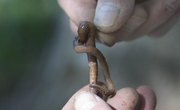
Spoons are among the oldest and simplest lures in many anglers' tackle boxes. The Little Cleo, first introduced by the Acme Tackle Company more than 30 years ago, offers a subtle variation on the traditional fishing spoon. The Little Cleo's broad metal body and unique humpbacked shape give it an erratic wiggling motion in the water, drawing strikes from a variety of game fish species.
What You Can Catch
Spoons like the Little Cleo are designed to imitate wounded baitfish, and most predatory fish will strike a spoon. The Little Cleo is available in nine sizes, ranging from the dainty 1/16-ounce spoon to the considerably heftier 1 1/4-ounce model. Lures on the lighter end of this spectrum are effective for catching small trout and panfish, while the heaviest Little Cleos excel at tempting salmon, pike and muskellunge. Midsize spoons are the most versatile, and they often get the call when anglers are after trout, steelhead, bass or walleye.
Where and When
Trout are arguably the most common quarry for the Little Cleo, and this lure is highly effective on rivers and streams during spring and fall, when steelhead, brown trout and rainbow trout undertake their annual spawning run. The Little Cleo's erratic motion can trigger reaction strikes from trout during the spawn season, causing them to strike out of instinct and aggression rather than anger. Little Cleos are also useful for smallmouth bass fishing on rivers and streams during summer. On lakes, Little Cleos are effective for trolling when trout and landlocked salmon school in deep water during summer.
Stream-Fishing Methods
When fishing in a river or stream, cast toward pockets in the current where fish rest. Pockets often form on the downstream end of rocks and logs. You can also use a Little Cleo to explore deep pools, which often form on the outside of a river bend, or in an area where fast-moving water spills over into deeper water. Areas with sudden depth changes or current breaks -- spots where slow and fast waters meet -- are generally good spots to cast a Little Cleo. For the most lifelike motion in moving water, cast your lure diagonally upstream or downstream rather than straight up or down, and keep your lure moving to maintain lifelike action and avoid snagging.
Lake-Fishing Methods
The Little Cleo's metal body is thicker and wider than many spoons, which means that it casts farther and swims deeper than a lot of other lures. This characteristic makes it a useful bait when game fish school in deep water around shelves, reefs, drop-offs and points. A stop-and-start retrieve is sometimes effective in lakes, but retrieving the lure in a straight line also works. Like most spoons, the Little Cleo is effective for trolling -- pulling the lure behind a boat at low speed -- to locate fish in open water. If you're fishing from the shore or a pier, cast the Little Cleo close to cover like rocks, weed beds, stumps, docks or fallen trees, but be careful to avoid tangling it in weeds and brush.
References
Writer Bio
When Richard Corrigan isn't writing about the outdoors, he's probably outside experiencing them firsthand. Since starting out as a writer in 2009, he has written for USA Today, the National Parks Foundation and LIVESTRONG.com, among many others, and enjoys combining his love of writing with his passion for hiking, biking, camping and fishing.



